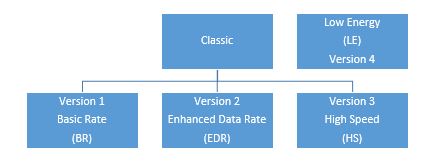

When you are selecting a Bluetooth or the other RF module for an Internet of Things (IoT) device or some other project, you’ll likely find many more viable options available on the market than you might imagine. Module manufacturers or suppliers normally classify the thousands of available modules by transmission rate, transmission distance, frequency band, certification, packaging size and more.
While the full set of considerations is important, some factors are more critical than others. By focusing first on transmission rate, transmission distance (or coverage), and power consumption, you can limit the field in a meaningful way. As these factors trade off each other, choosing a module based on these criteria initially can help you make decisions that directly impact your end user’s experience. Let’s take a quick look at these parameters and how they can impact your device performance.
Transmission rate
Transmission rate, or data rate, is usually the first thing designers and developers consider because it forces them to think about the kind of information that needs to be transmitted between devices. For example, the data rate you want for transmitting high quality music to headphones is very different from the data rate required for a basic heartrate monitor.
Modulation Method | Data rate | |
|---|---|---|
Basic rate | GFSK | 1 MB/s |
Enhanced data rate | π/4-DQPSK | 2 MB/s |
8DPSK | 3 MB/s | |
Low energy | GFSK | 1 MB/s |
Theoretically, the transmission rate of low energy Bluetooth will not support its own maximum band width (1 MHz), because low energy Bluetooth focuses on simple information transmission. If the data is transmitted at a high rate, the low energy Bluetooth will consume greater power, which is contradictory to the original design concept. If high speed transmission is needed, the EDR Bluetooth or Wi-Fi with higher rate should be considered. Any rate increase will almost definitely consume more power.
Power class and transmission distance coverage range
On manufacturer and distributor websites, Bluetooth modules are filterable by class. This refers to their power class. The greater the power class, the farther the place can be reached by the transmission. A Bluetooth network has a limited distance like any other wireless technology. The transmission distance varies with different versions. In the same version, the transmission distance supported also varies with different power classes.
Power classification | TRANSMISSION DISTANCE | Maximum power (dBm) | Power control requirement |
|---|---|---|---|
1 | 100 meter radiation distance at maximum, mainly applicable for industry | 20 | Mandatory |
2 | 10 meter radiation distance at maximum, under which most mobile devices fall | 4 | Not mandatory |
3 | 1 meter radiation distance at maximum, applicable for extra-short distance transmission | 0 | Not mandatory |
The real distance of signal transmission varies with specific environmental conditions, such as the transmission conditions, material, production deviation, antenna and battery. Besides the requirements specified in the Bluetooth standards, the equipment also needs to meet the power requirements specified by the spectrum regulatory authority under the local government. For more information on these requirements, check out our earlier blog entry.
Power consumption
Power consumption is largely a function of the transmission rate and distance. As the Bluetooth device is generally powered by a battery, the operating current/voltage of equipment are an important consideration as it directly determines the charging cycle and battery life.
Bluetooth SIG simplifies this initial decision by classifying modules further into versions. Versions of Bluetooth technology are classified into classic and low-energy (LE) versions. The classic Bluetooth versions 1, 2 and 3 are optimized for data transmission rate. In the classic type, it is subdivided into the basic rate (BR), enhanced data rate (EDR) and high speed. The low-energy Bluetooth focuses more on simple information transmission while trying to extend the endurance time of electronics as long as possible.

Outside of these classifications, manufacturers will list transmit and receive current and/or power, which is enormously useful in module selection. If you can test the projected end device usage, you can more easily evaluate modules that make the most of the various tradeoffs in your application specifically. Read more about this sort of testing in our power consumption blog post.
Finding the right Bluetooth module starts with managing the tradeoffs between transmission rate, transmission distance and power consumption. Once you’ve narrowed the field a bit, you can start to narrow it further per your cost, footprint, and compatibility. Finally, you should expect to do some evaluation of the module using test equipment. Download the How to Select a Bluetooth Module application note and visit the USB RSA product page for a more detailed look at this testing.


